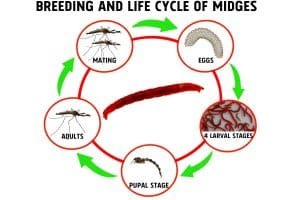
Understanding how bloodworms feed can feel like peeling back the layers of an onion. Each layer reveals more about their adaptations, habitat, and the overall importance of these critters in the environment. So, let’s dive into the world of bloodworms and break down their feeding mechanism step by step.
What Are Bloodworms?
Bloodworms are the larval stage of the midge fly, belonging to the family Chironomidae. They thrive in aquatic environments, typically found in ponds, marshes, and other still waters. These larvae can grow up to 2.5 inches long and are known for their striking red color, which comes from the hemoglobin in their blood. This helps them survive in low-oxygen conditions, making them effective scavengers.
You might wonder why they are significant in their environment. Bloodworms play a vital role in breaking down organic matter. They consume decaying plant material and other organic debris, helping to recycle nutrients back into the ecosystem. In turn, they serve as a food source for many fish and birds, creating a vital link in the food chain.
The Anatomy of a Bloodworm
To understand how bloodworms feed, it helps to look at their anatomy. Bloodworms have a long, segmented body that enables them to navigate through their aquatic habitats easily. Their bodies are covered in bristles called setae, which help in movement by gripping onto surfaces and creating a current in the water.
At the front end, they have a distinct head equipped with a pair of jaws. These jaws are crucial for their feeding process. They can open and close to grasp onto food particles, allowing them to consume the organic matter in their surroundings. This specialized mouthpart, along with their body structure, makes bloodworms effective at scavenging for food.
How Bloodworms Eat: The Step-By-Step Process
Now that we’ve covered what bloodworms are and their anatomy, let’s get into the nitty-gritty of how they actually eat. It’s a fascinating process that resembles a scavenger hunt in the water.
Step 1: Locating Food
Bloodworms are constantly on the lookout for food. They use their sensory receptors to detect organic debris and decaying matter in their environment. The presence of certain chemicals in the water can signal to them that it’s time to feast.
Step 2: Grasping Food
Once they’ve found a meal, bloodworms use their jaws to grab hold of it. Their jaws can move like pincers, allowing them to latch onto food particles. This is crucial when they are feeding on soft, decaying plant matter or small microorganisms.
Step 3: Ingesting Food
After grasping their food, bloodworms begin to ingest it. They suck in the organic material using a series of rhythmic muscle contractions. This process ensures that they get as much food as possible during each feeding session.
Step 4: Digestion and Nutrient Absorption
Once the food is ingested, it moves into their digestive system. Here, the nutrients are broken down and absorbed. Bloodworms are very efficient at extracting nutrients, which is essential for their growth and development into adult midges.
Diet of Bloodworms
You might be surprised to learn that bloodworms aren’t picky eaters. They have a varied diet, which is one reason why they thrive in different water conditions. Here’s a closer look at what they consume:
- Decaying Plant Matter: Bloodworms primarily feed on decomposed leaves, algae, and other organic material.
- Bacteria and Microorganisms: These tiny creatures also munch on bacteria, which helps keep the water clean by breaking down waste.
- Small Invertebrates: Occasionally, they will consume small aquatic invertebrates, adding protein to their diet.
By breaking down this organic matter, bloodworms not only feed themselves but also contribute to a healthier aquatic ecosystem.
Importance of Bloodworms in Ecosystems
The role of bloodworms goes beyond simple scavenging. They play a vital part in maintaining the health of aquatic ecosystems. As they consume organic matter, they facilitate the recycling of nutrients. This process not only helps plants grow but also supports various fish species that rely on bloodworms as a food source.
In fact, many fishermen consider bloodworms a prime bait for catching fish, such as bass and trout. Their high protein content makes them incredibly attractive to fish. So, when you see a bloodworm, remember it’s not just a worm; it’s an essential player in the aquatic food web.
Challenges Bloodworms Face
Despite their adaptability, bloodworms face several challenges in their environment. Changes in water quality, pollution, and habitat loss can threaten their populations.
Poor water quality can lead to a lack of food sources, which can impact their growth and survival. Moreover, with the rise of urban development, many natural habitats for bloodworms are shrinking. Protecting these ecosystems is crucial for ensuring the survival of this industrious little creature.
So, there you have it! Understanding the feeding mechanism of bloodworms gives us a glimpse into the incredible adaptations of this tiny creature. From their unique anatomy to their role in the ecosystem, bloodworms are more than meets the eye. They help break down organic material, contribute to nutrient cycling, and serve as vital food sources.
Next time you’re near a pond or marsh, consider the bloodworm and its fascinating world. It’s a reminder of how interconnected life is and how even the smallest creatures play a big part in nature. So, whether you’re fishing, studying aquatic biology, or simply enjoying the great outdoors, remember that bloodworms are working hard beneath the surface, making the world a little better for all of us.
